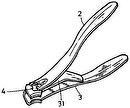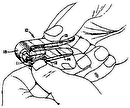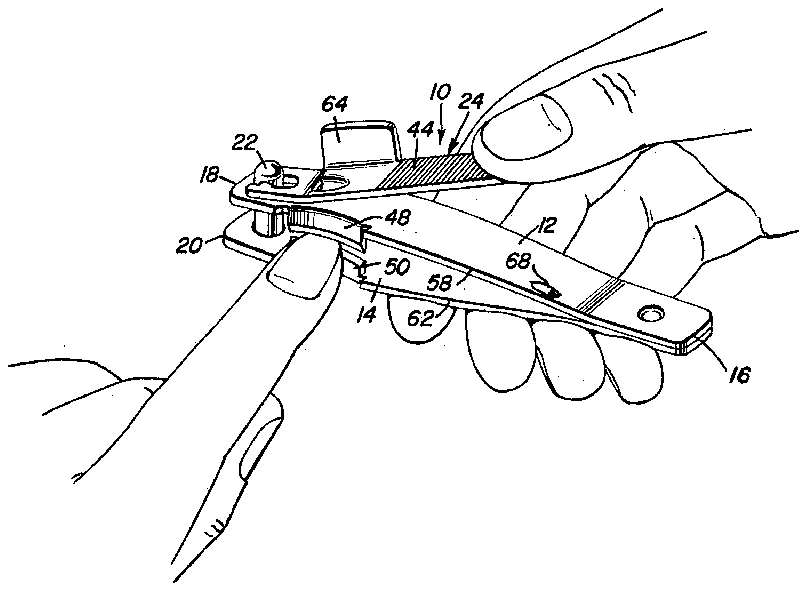

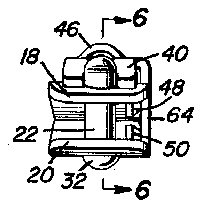
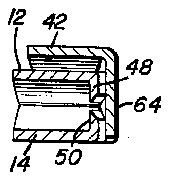
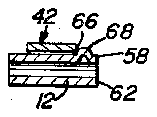
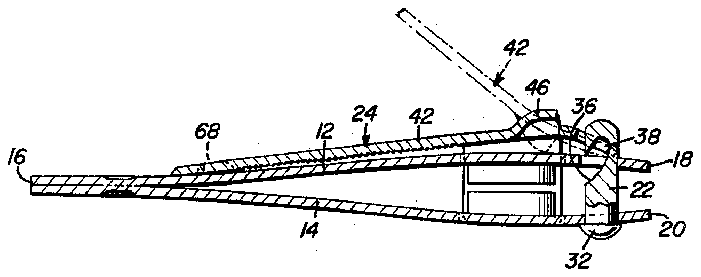
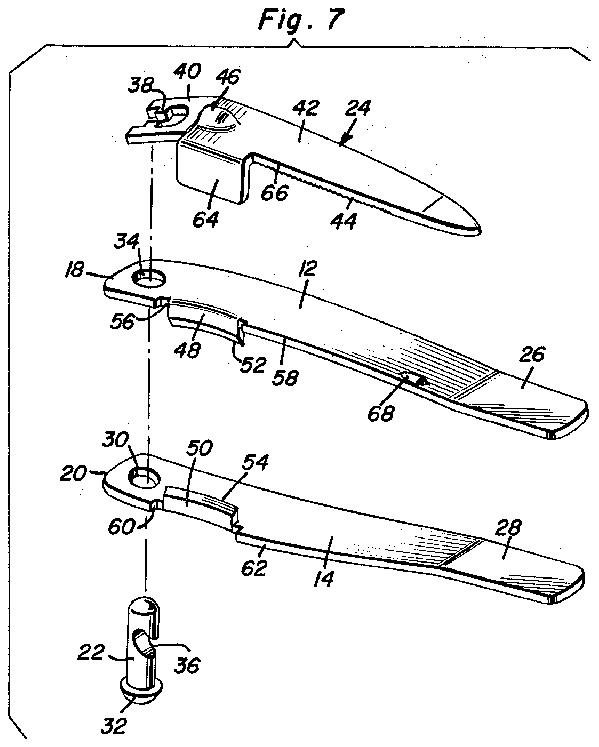
- 3jr
- 5fig- ures
- 10nail clipper
- 12leaf
- 14leaf
- 16one end
- 18end
- 20ends
- 22stud
- 24pressure bar
- 26end portion
- 28end portion
- 32head portion
- 34aperture
- 36notch
- 38pivot projections
- 40end portion
- 42elongated actuating portion
- 44filing surface
- 46pressure projection
- 48cutting element
- 50cutting elements
- 52edges
- 54edges
- 58longitudinal sides
- 60recesses
- 62longitudinal sides
- 64guard projection
- 66longitudinal side
- 68limit stop
- 88oski 3028 3,042,047 7/ 62 plaskon 3028 x
- 189jr
- 204oski 3028 3,042,047 7/ 62 plaskon 3028 x
- 398examiner united states patents
- 626tes patents 2,704,398 3/55 hunt 30 -28 x
- 704examiner united states patents
- 753tes patents 2,704,398 3/55 hunt 30 -28 x
- 996jr
Description
June 1965 w. D. CASEY, JR 3,189,996</span>
NAIL CLIPPER WITH PROTECTIVE GUARD Filed Nov. 6, 1963 2 Sheets-Sheet 1 William 0. Casey, Jr.
1 N VEN TOR.
Y Wyn gym J1me 1965 w. D. CASEY, JR 3,189,996</span>
NAIL CLIPPER WITH PROTECTIVE GUARD Filed Nov. 6, 1965 2 Sheets-Sheet 2 I Fig.6 4e
William 0. Casey, Jr.
IN VEN T 0R.
Mad-2 By United States Patent 3,189,996 NAIL CLIPPER WITH PROTECTIVE GUARD William D. Casey, Jr., 3570 Autumn Ave., Memphis, Tenn. Filed Nov. 6, 1963, Ser. No. 321,818 3 Claims. (Cl. 30-28) This invention relates to improvements in nail clippers, particularly clippers designed for the cutting of fingernails.
Nail clippers of the type with which the present in vention is concerned, while being portable because of size and compactness, are nevertheless often dangerous because of the exposed cutting edges thereon which are also liable to cause damage to material and fabric adjacent thereto which may be caught on the sharp cutting edges. It is therefore a primary object of the present invention to provide an improved nail clipper of the aforementioned type which is safer to carry and less likely to damage material in contact therewith.
An additional object of the present invention is to provide an improved nail clipper of the aforementioned type incorporating a protective safety feature which is relatively inexpensive.
A still further object of the present invention is to provide a nail clipper embodying a protective safety feature that is reliable and which does not disturb the compact nature of the type of nail clipper involved.
These together with other objects and advantages which will become subsequently apparent reside in the details of construction and operation as more fully hereinafter described and claimed, reference being had to the accompanying drawings forming a part hereof, wherein like numerals refer to like parts throughout, and in which:
FIGURE 1 is a perspective view showing the improved nail clipper of the present invention in use.
FIGURE 2 is a top plan view of the nail clipper in a closed position.
FIGURE 3 is a forward end View of the nail clipper.
FIGURE 4 is a transverse sectional view taken substantially through a plane indicated by section line 44 in FIGURE 2.
FIGURE 5 is a transverse sectional view taken substantially through a plane indicated by section line 5-5 in FIGURE 2.
FIGURE 6 is a longitudinal sectional view taken substantially through a plane indicated by section line 6-6 in FIGURE 3.
FIGURE 7 is a perspective view of the disassembled parts of the nail clipper.
Referring now to the drawings in detail, it will be observed from FIGURE 1 that the nail clipper generally referred to by reference numeral 10 is in an active or actuating position, held in one hand of the user for cutting the fingernails of the other hand. The nail clipper is of the type which involves a pair of elongated spring leaves 12 and 14 secured together at one end 16 by any suitable means such as by brazing. The opposite unsecured ends 18 and 20 of the spring leaves are resiliently held spread apart by a stud 22. Pivotally mounted on the stud 22 is a pressure bar 24 adapted to be rotationally displaced between an actuating position illustrated in FIG- URE 1 and shown by dotted line in FIGURE 6 and a closed position shown in FIGURE 2 and by solid line in FIGURE 6.
Nail clippers of the aforementioned type are well known in that the upper spring leaf 12 is provided with an end portion 26 adapted to be secured to the end portion 28 of the lower spring leaf 14 as more clearly seen in FIGURE 7, the opposite operative ends 18 and 20 of the spring leaves being separated by the stud 22 "ice firmly secured to the leaf 14 within the aperture 30 thereof, the stud having its head portion 32 engaging the underside of the leaf 14 adjacent to the end 20. The shank of the stud 22 therefore slidably extends through the aperture 34 formed adjacent the end 18 of the leaf 12 so that the notch 36 formed in the shank of the stud may pivotally receive the pivot projections 38 which extend from the bifurcated end portion 40 of the pressure bar 24. The pressure bar is therefore provided with an elongated actuating portion 42 one side of which includes a filing surface 44 exposed upwardly when the pressure bar is in the actuating position shown in FIGURE 1. An actuating pressure projection 46 is formed on the surface of the pressure bar opposite the filing surface 44 adjacent to the end portion 40, so that when the pressure bar is in the actuating position, the projection 46 will bear against the upper surface of the leaf 12 adjacent the op-' erative end 18 in order to permit the user to slidably displace the upper leaf 12 towards the lower leaf 14 in order to effect the cutting action. The pressure bar when rotationally displaced from the actuating position by degrees, in a plane perpendicular to the axis through the stud 22, may then be angularly displaced toward the closed or inactive position illustrated in FIGURES 2, 3 and 6 with projection 46 extending upwardly and the elongated actuating portion 42 engaging the top surface of the upper leaf 12 at its end. p
The upper and lower leaves are respectively provided with cutting elements 48 and 50 which are arcuate in shape for shaped cutting of the fingernails. The cutting elements are therefore provided with arcuate knife cutting edges 52 and 54 which confront each other. The cutting element 48 therefore extends downwardly from the upper leaf 12 and is located within a lateral recess 56 formed on one longitudinal side 58 of the leaf 12 adjacent to the operative end 18. It will therefore be observed, that the pressure bar will have its pressure projection 46 aligned with the cutting element 48 so that upon slidable displacement, maximum pressure will be applied to the cutting element 48 bringing it toward the cutting element 50 projecting upwardly from the lower leaf 14. The lower leaf is therefore also provided with a recess 60 on the longitudinal side 62 thereof aligned with the recess 56 in the upper leaf 12. It will therefore be apparent, that the disposition of the cutting ele' ments 48 and 50 recessed inwardly from the longitudinal sides 58 and 62, will not only bring them closer to the point of maximum pressure applied by the pressure projection 46, but will also render the knife edges 52 and 54 less exposed.
In order .to provide complete shielding protection for the cutting elements 48 and 50, the pressure bar 24 is provided with a guard projection 64 which extends laterally fr-om one longitudinal side 66 of the pressure bar adjacent to the pressure projection 46 so that the guard 64 may be aligned with the recesses 56 and 60 in the spring leaves when the pressure bar is in the closed position. The guard projection 64 therefore is spaced from the longitudinal side 66 of the pressure bar and extends perpendicular thereto in protective shielding relation to the cutting elements as more clearly seen in FIGURE 4, when the pressure bar is in the closed position. In the closed position, the guard projection 64 will extend through the recesses 56 and 60 and be flush with the longitudinal sides 62 and 58 of the leaves as more clearly seen in FIGURE 2. Accordingly, the compact nature of the nail clipper 10 in its closed position will be preserved. In order to assure that the pressure bar is in the proper closed position and to avoid lateral displacement of the guard 64 from the sides 58 and 62, a limit stop 68 is formed on the upper surface of the leaf 12 adjacent side ent.
58 for engagement by the pressure bar as shown in FIG- URES 2 and 5.
From the foregoing description, the construction, operation and utility of the improved nail clipper will be apparmay be safely carried in the purse or pocket of the user without any danger of injury to the user or damage to fabric. The disposition of the cutting elements Will also :facilitate the cutting action as well as to accommodate the safety guard feature. Also, the shielding protection provided by the guard feature will avoid damage to surfaces that could occur in connection with nail clippers having exposed cutting edges.
The foregoing is considered as illustrative only of the principles of the invent-ion. Further, since numerous modifications and changes will readily occur to those skilled in the art, it is not desired to limit the invention to the exact construction and operation shown and described, and accordingly all suitable modifications and equivalents may be resorted to, falling within the scope of the invention as claimed.
What is claimed as new is as follows:
1. A nail clipper having a pair of elongated leaves secured together adjacent one end and resiliently separated at an opposite end, confronting knife edges projecting from said leaves on one lateral side thereof adjacent said opposite end, a pressure bar movably mounted at said opposite end of the leaves for displacement between a closed and an actuating position, and a guard project-ion extending from said pressure bar laterally aligned with the con-fronting knife edges for protective shielding thereof when the pressure bar is in the closed position.
2. In combination with a nail clipper having a pair of elongated spring leaves held in resiliently separated rela- It will therefore be appreciated, that the nail clippertion at an operative end for displacement toward each other, by a pressure bar when displaced from an inactive,
position to an actuating position, a pair of confronting knife edges extending from said leaves on one lateral side adjacent said operative end, said leaves being formed with recesses on said one lateral side from which the knife edges extend toward each other, and guard means connected to said pressure bar for projection through said recesses when the pressure bar is in the inactive position to protectively shield the knife edges.
3. In a nail clipper having a pair of elongated spring leaves held in resiliently separated relation at an operative end by a stud which pivotally mounts a pressure for rotatable between a closed position and an actuating position for slidably displacing one of the leaves toward the other at said operative end; a pair of confronting knife edges extending from said leaves on one lateral side adjacent said operative end, said leaves being formed with aligned recesses on one lateral :side from which the knife edges extend toward each other, guard means connected to said pressure bar for projection through said recesses when the pressure bar is in the closed position to protectively shield the knife edges, and limit means mounted on said one of the leaves for engagement by the pressure bar to limit movement thereof toward the closed position.
References Cited by the Examiner UNITED STATES PATENTS 2,704,398>>> 3/55 Hunt 30 -28 X 2,753,626 7/56 Bowers 30-28 2,960,766 11/60 Whittle 30-28 3,031,754 5/62 Pocoski 3028 3,042,047 7/ 62 Plaskon 3028 X 3,088,204 5/63 Levitt 3028 WILLIAM FELDMAN, Primary Examiner.
MYRON C. KRUSE, Examiner.





